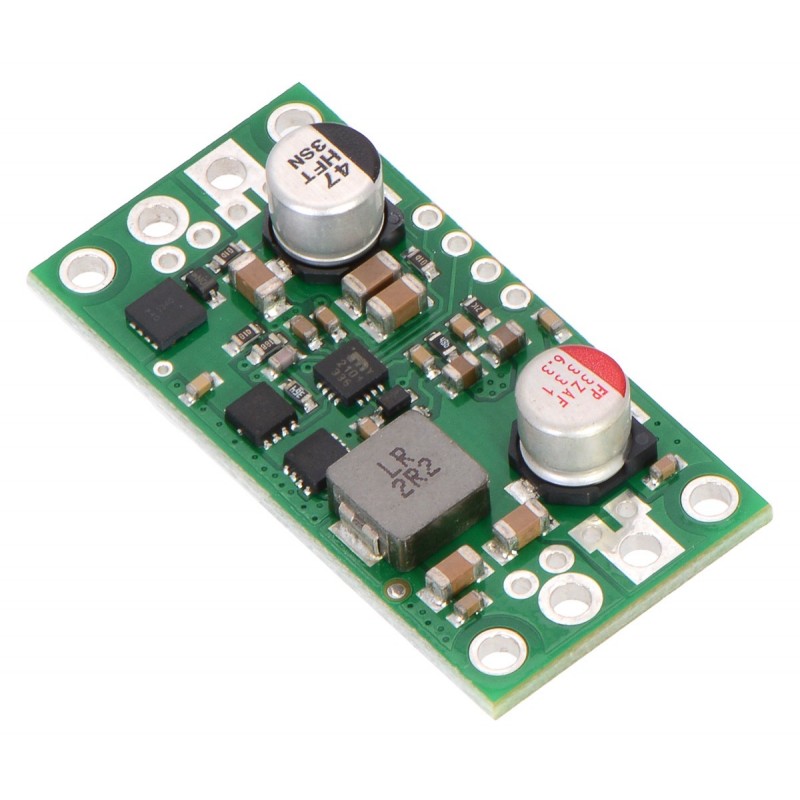

No products in the cart.


Pololu 5V, 6A Step-Down Voltage Regulator D24V60F5
This synchronous switching step-down (or buck) regulator takes an input voltage of up to 38 V and efficiently reduces it to 5 V while allowing a typical continuous output current of up to 6 A. Typical efficiencies of 80% to 95% make this regulator well suited for higher-power applications like powering motors or servos, while high efficiencies are maintained at light loads by dynamically changing the switching frequency, and an optional shutdown pin enables a low-power state with a current draw of a few hundred microamps. The regulator’s output voltage setting can also be lowered by adding an external resistor.
These high-current step-down (buck) regulators generate a fixed 5 V output from input voltages up to 38 V. They are switching regulators (also called switched-mode power supplies (SMPS) or DC-to-DC converters) and have a typical efficiency between 80% to 95%. The available output current is a function of the input voltage and efficiency (see the Typical Efficiency and Output Current section below), but the output current can typically be as high as 6 A.
A very similar version of this regulator is available with a typical maximum output current of 9 A. The two versions of the board are difficult to tell apart visually, so the bottom silkscreen includes a blank space where you can add your own distinguishing marks or labels. You should not use the colors of the printing on the tall, cylindrical electrolytic capacitors to differentiate the two versions as these colors are subject to change. We also carry two much smaller versions of this regulator, one with a typical maximum output current of 2.5 A and one with a typical maximum output current of 5 A.
The ENABLE pin can be used to put the board in a low-power state that reduces the quiescent current to approximately 10 µA to 20 µA per volt on VIN, and a PG (power good) indicator makes it easy to monitor the state of the main power for your system. The regulator’s output voltage setting can also be lowered by adding an external resistor.
This regulator has built-in reverse-voltage protection, short-circuit protection, thermal shutdown (which typically activates at 160°C), a soft-start feature that reduces inrush current, and an under-voltage lockout that causes the regulator to turn off when the input voltage is below 4.2 V (typical).
| Pololu 5V, 6A Step-Down Voltage Regulator D24V60F5, side view. |
|---|
This buck regulator has six connections: input voltage (VIN), ground (GND), output voltage (VOUT), feedback (FB), ENABLE, and power good (PG).
The input voltage, VIN, powers the regulator and can be supplied with voltages up to 38V. The effective lower limit of VIN is VOUT plus the regulator’s dropout voltage, which varies approximately linearly with the load from around 500 mV to a little over a volt (see below for a graph of the dropout voltage as a function of the load).
The output voltage, VOUT, is set to 5V by default. The output voltage can optionally be lowered by adding a resistor between the FB pin and VOUT as detailed in the Decreasing the output voltage section below.
The regulator is enabled by default: a 100 k? pull-up resistor on the board connects the ENABLE pin to reverse-protected VIN. The ENABLE pin can be driven low (under 0.6 V) to put the board into a low-power state. The quiescent current draw in this sleep mode is dominated by the current in the pull-up resistor from ENABLE to VIN and by the reverse-voltage protection circuit, which will draw between 10 µA and 20 µA per volt on VIN when ENABLE is held low. If you do not need this feature, you should leave the ENABLE pin disconnected.
Dimensions
| Size: | 1.6? × 0.8? × 0.3?1 |
|---|---|
| Weight: | 4.8 g1 |
| Minimum operating voltage: | 5 V |
|---|---|
| Maximum operating voltage: | 38 V |
| Continuous output current: | 6 A2 |
| Output voltage: | 5 V |
| Reverse voltage protection?: | Y |
| Maximum quiescent current: | 15 mA3 |
"